|
|
|
|
|
|
"Mohala i
ka wai ka maka o ka pua."
Unfolded
by water are the faces of flowers.
Flowers thrive where there
is water,
as thriving people are found where living conditions are good.
'Olelo Noeau
# 2178
|
|
|
|
| Restoration is
the return of a degraded ecosystem to a close approximation
of it's remaining natural potential.
Can the stream ecosystems of Nawiliwili Bay
be restored? The answer is yes. But what is the remaining
natural potential? This is what our assessment should
tell us. |
|
|
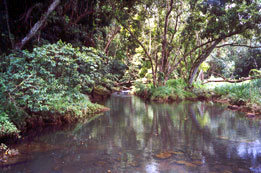 |
|
|
|
|
We know some of the problems that
restoration has to deal with already. We review the physical,
chemical, and biological conditions separately, although they
work together as one system. Then we speak about the most important
element of all - the modern day maka'ainana. |
|
A major source for Restoration
is Aquatic Species Survey and Biological Assessment
of Lihu'e, Kaua'i Streams Intersected by Kamuali'i Highway,
Lihu'e to west of Maluhia Road (Koloa) by Michael H. Kido. |
|
|
|
|
Physically, the streams of Nawiliwili are interrupted and diverted
by reservoirs and ditches in their upper reaches.(Kido)
Photo by Adam Asquith |
|
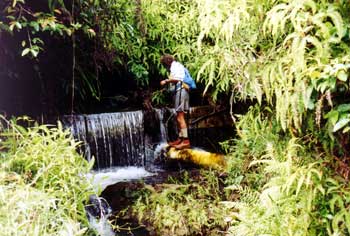 |
|
|
|
|
|
|
|
 |
|
|
Although the sugar industry is pau (ended),
this diversion of 100% of Hule'ia
Stream's base flow continues to send water out
of the watershed to Waita Reservoir. The stream bed continues
dry for a hundred yards, and then the ground water begins
to recharge the stream flow. Don Heacock, aquatic specialist,
says that if we could only choose one thing to do towards
restoration, returning to the Ahupua'a policy of diverting
no more than 50% of the stream flow would provide the most
benefit to the stream ecosystems. Photo by Adam Asquith
|
|
|
|
|
| Now that sugar is gone,
what happens to the plantation's huge system of ditches, reservoirs,
and diversions? What happens to the water that flows through
them? The Hawai'i Supreme Court has said that all public
natural resources are held in trust by the state for the benefit
of the people. (Wilcox) The exact meaning of this with respect
to water in the ahupua'a of Nawiliwili Bay is still a question. |
|
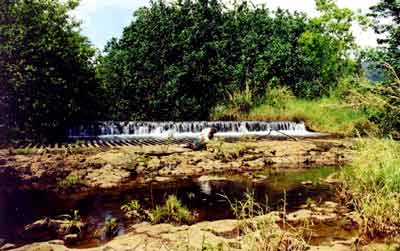 |
|
|
|
|
|
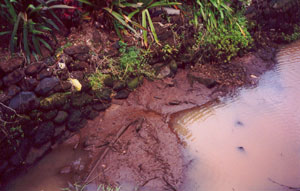 |
|
In some streams chronic sedimentation
over a long period of time has produced clay bottoms from solidified
mud.(Kido) This is not unlike the plaque that builds up in our
own arteries from a diet too rich in saturated fats. What? Go
on a diet? |
|
|
|
|
The construction of the harbor at Nawiliwili has interrupted
the flow of sediment out to sea, thus sediment is deposited
in the harbor and on the reefs. (Asquith, personal communication)
When large surf arrives, this sediment is reintroduced into
the water.
|
|
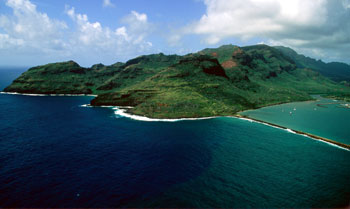 |
|
|
|
|
Notice the difference in the color
of the ocean and harbor water. Without the breakwater, the sediment
would move out into the long shore flow.
Photo by David Boynton, Casey Riemer pilot - Jack Harter Helicopters. |
|
|
|
|
|
|
|
|
|
| Biologically, alien
introduced species dominate to the near exclusion of native
species. The upper reaches of Nawiliwili's five streams are
primarily poeciliid fish (small mouth bass, guppies, sword tail,
medaka). Hinana (young 'o'opu) are like
candy to these introduced fish. Many areas of Nawiliwili's streams
are a poor habitat for native species because of severe sedimentation,
dewatering, bank erosion and human impacts to riparian areas.
(Kido) The riparian zone and forests are mostly alien species. |
|
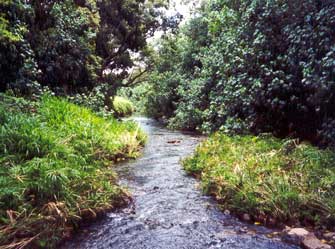 |
|
|
|
Adam Asquith says that
a major biological problem in the streams of Nawiliwili Bay
is Leptospirosis. This microorganism is introduced into
the streams by the urine of animals. Any person exposed to stream
water with an open cut is susceptible to infection. |
|
|
|
|
|
Chemically, the urbanization
and development of Lihu'e around the five streams of Nawiliwili
creates the potential for harmful chemical point and non-point
source pollution. Nawiliwili Bay had the distinction of being
closed more times last year because of pollution than any other
bay in the islands. (Heacock) |
 |
|
|
|
|
|
|
Wal-Mart is a model of best management practices for dealing
with non-point source pollution. Their parking lot is surrounded
by a grassy moat
|
|
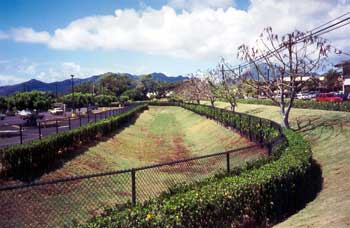 |
|
|
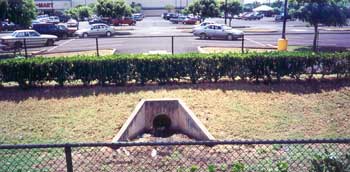 |
|
When it rains, the run-off is directed into these moats |
|
|
Rubbish is periodically removed, and non-point source pollution
is kept out of the streams and oceans. |
|
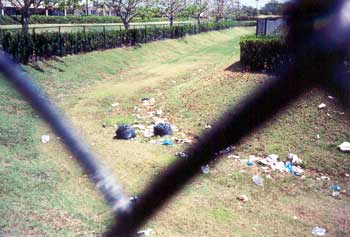 |
|
|
|
|
Restoration involves more than the physical, biological, and
chemical problems. The most important
element of all is cultural. How do today's maka'ainana
of Nawiliwili feel about their home? What are they willing
to do in support of restoration? How do today's large land owners
feel about their home? What are they willing to do in support
of restoration? |
|
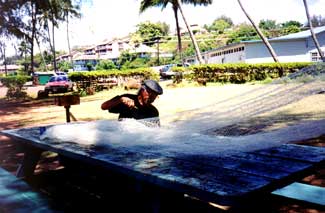 |
|
|
|
Two citizens' groups involved in
support of restoration are PISCES (Pacific Island's Sustainable
Community Ecosystems) and the Nawiliwili Bay Watershed Council.
These two groups are working together to identify and establish
a community-based partnership with various government agencies
in order to develop resource protection for the 'ainakumuwai
of Nawiliwili. Here is the mauka
to makai view. |
|
|
|
|
September of 2000 was the first Nawiliwili Bay Watershed
Festival.
|
|
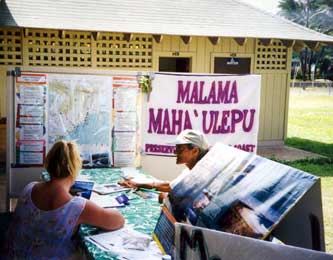 |
|
|
|
|
|
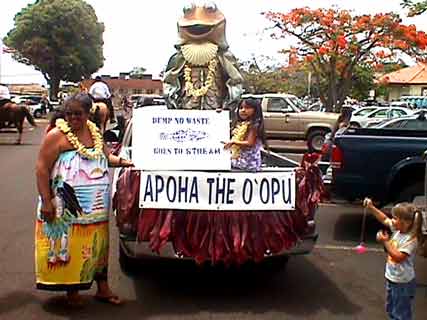 |
|
Education is a major priority of the Nawiliwili Bay Watershed
Council.
|
|
Apoha the o'opu
Photo courtesy of John Schlegel
|
|
|
|
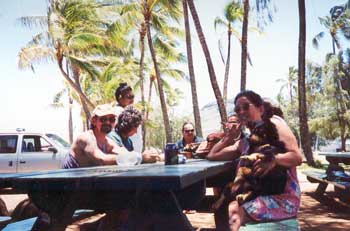 |
|
Here are some comments from members of the community -
Carlos Andrade: "Our biggest issue is, how do you keep
a community focused on a goal that is such a long-term goal,
and keep them working together in relative states of harmony,
and not be discouraged?" (from Pacific World's Ha'ena
by RDK Herman)
|
|
|
|
|
|
|
|
Chipper Wichman :"The key here is to malama. If
you can get into being inside of that ecosystem, from the Hawaiian
perspective, be a part of it, you become part of that balance."
(from Pacific World's Ha'ena by RDK Herman) |
|
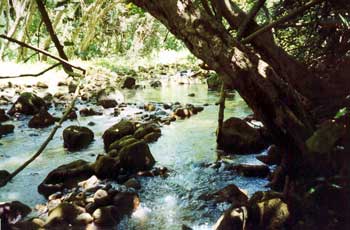 |
|
|
 |
|
Samson Mahuiki: "Gotta be in you. If it's in you, it'll
work. If you can change the mind, then it'll work. Otherwise
it's only talk." (from Pacific World's Ha'ena by
RDK Herman) |
|
|
|
|
|
|
Adam Asquith: "What's wrong with this picture? There are
no people in this picture - working and caring for the land." |
|
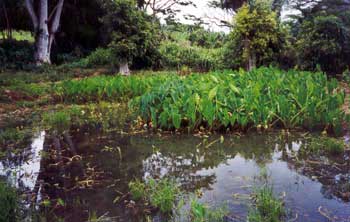 |
|
|
|
|
|
Niumalu Dunes. Photographer:
Theodore P. Severin
Photo courtesy of the Bishop Museum
|
|
|
Cheryl Lovell-Obatake: "At Niumalu before - I could
see the kuhonu crab walking into the nets. What compels
me are the things that I've seen and done in nature. These
compel me to go to public hearings. At least try to make the
effort for the water quality, and it feels good when I do.
At least I make the effort, rather than being frustrated and
mad."
|
|
|
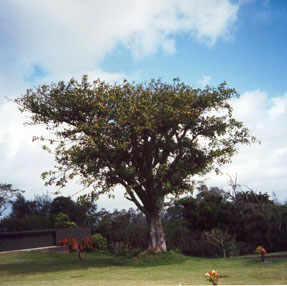 |
|
When humans arrived at Nawiliwili Bay over a thousand
years ago, they began changing their new island home to
suit their needs. In 'Ainakumuwai:
Ahupua'a of Nawiliwili Bay, we have examined the
attitudes and effects of the ahupua'a and plantation management
systems on land, water, and sustainability at Nawiliwili
Bay. As we continue to change our island home, the effects
of our decisions will be visible in the streams and water
of Nawiliwili Bay. We have looked at what was and what
is. What will be is our kuleana (responsibility). |
|
|
|
|
|
|
|
Wiliwili at Nawiliwili
|
|
|
|
|
|
|
|
|
|
|
|
|
|
|
|
|
|
|
|
|
|

